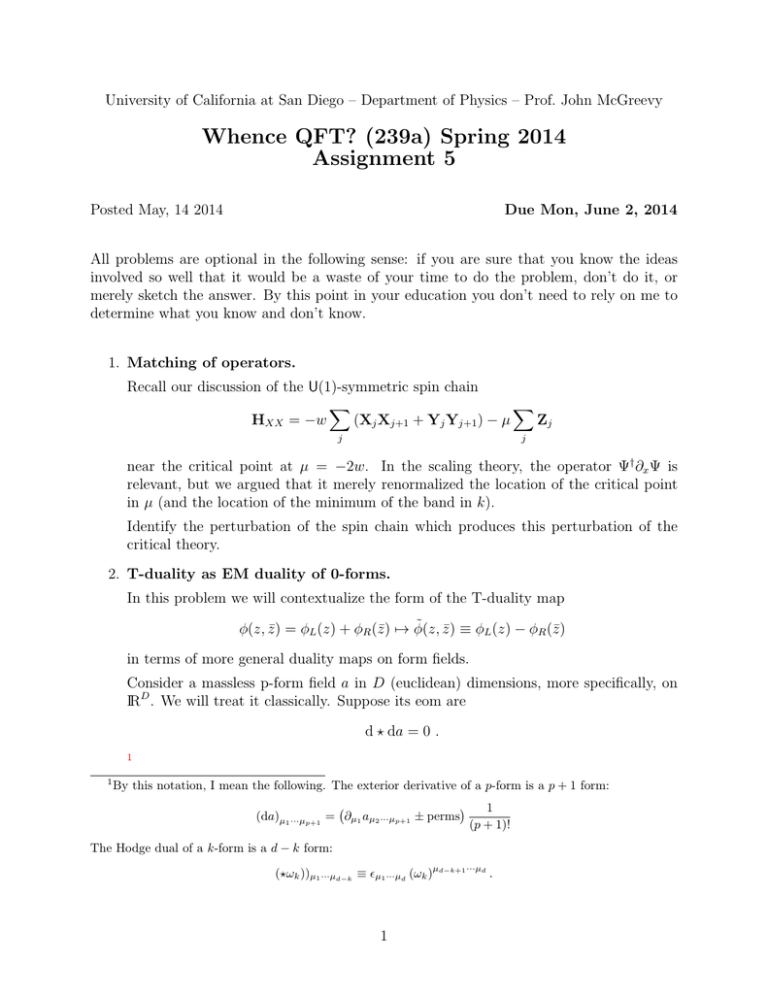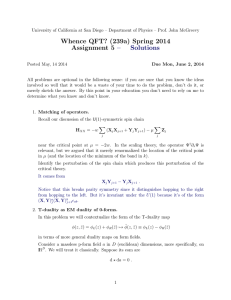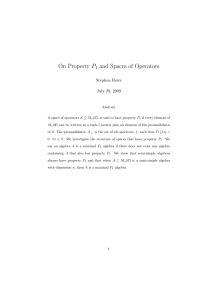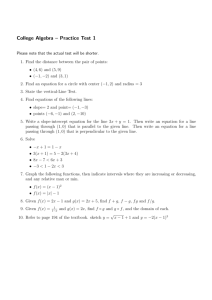Whence QFT? (239a) Spring 2014 Assignment 5
advertisement

University of California at San Diego – Department of Physics – Prof. John McGreevy Whence QFT? (239a) Spring 2014 Assignment 5 Posted May, 14 2014 Due Mon, June 2, 2014 All problems are optional in the following sense: if you are sure that you know the ideas involved so well that it would be a waste of your time to do the problem, don’t do it, or merely sketch the answer. By this point in your education you don’t need to rely on me to determine what you know and don’t know. 1. Matching of operators. Recall our discussion of the U(1)-symmetric spin chain X X HXX = −w (Xj Xj+1 + Yj Yj+1 ) − µ Zj j j near the critical point at µ = −2w. In the scaling theory, the operator Ψ† ∂x Ψ is relevant, but we argued that it merely renormalized the location of the critical point in µ (and the location of the minimum of the band in k). Identify the perturbation of the spin chain which produces this perturbation of the critical theory. 2. T-duality as EM duality of 0-forms. In this problem we will contextualize the form of the T-duality map φ(z, z̄) = φL (z) + φR (z̄) 7→ φ̃(z, z̄) ≡ φL (z) − φR (z̄) in terms of more general duality maps on form fields. Consider a massless p-form field a in D (euclidean) dimensions, more specifically, on IRD . We will treat it classically. Suppose its eom are d ? da = 0 . 1 1 By this notation, I mean the following. The exterior derivative of a p-form is a p + 1 form: (da)µ1 ···µp+1 = ∂µ1 aµ2 ···µp+1 ± perms 1 (p + 1)! The Hodge dual of a k-form is a d − k form: µd−k+1 ···µd (?ωk ))µ1 ···µd−k ≡ µ1 ···µd (ωk ) 1 . This equation says ?da is closed, which on IRD which has no nontrivial topology, this means it is exact: we can define ?da = dã. For abelian gauge theory in D = 4 show that this map a → ã takes (E, B) → (Ẽ, B̃) = (B, −E). Show that the map between φ and φ̃ is of this form, if we regard φ as a 0-form potential. For help see this nice new paper by Chris Beasley. 3. SU(2) current algebra from free scalar. Consider a compact free boson φ ' φ + 2π in D = 1 + 1 with action Z R2 dxdt∂µ φ∂ µ φ. S[φ] = 8π (1) φ̃ ≡ Rφ then we absorb the coupling R from the action [Notice that R if we redefine 1 µ S[φ̃] = 8π dxdt∂µ φ̃∂ φ̃ but now φ̃ ' φ̃ + 2πR has a different period – hence the name ‘radius’.2 ] So: there is a special radius (naturally called the SU(2) radius) where new operators of dimension (1, 0) and (0, 1) appear, and which are charged under the boson number current ∂± φ. Their dimensions tell us that they are (chiral) currents, and their charges indicate that they combine with the obvious currents ∂± φ to form the (Kac-MoodyBardakci-Halpern) algebra SU(2)L × SU(2)R . Here you will verify that the model (1) does in fact host an SU (2)L × SU (2)R algebra involving winding modes – configurations of φ where the field winds around its target space circle as we go around the spatial circle. We’ll focus on the holomorphic (R) part, φ(z) ≡ φR (z); the antiholomorphic part will be identical, with bars on everything. Define J ± (z) ≡: e±iφ(z) :, J 3 ≡ i∂φ(z). The dots indicate a normal ordering prescription for defining the composite operator: no wick contractions between operators within a set of dots. (a) Show that J 3 , J ± are single-valued under φ → φ + 2π. (b) Compute the scaling dimensions of J 3 , J ± . Recall that the scaling dimension ∆ of a holomorphic operator in 2d CFT can be extracted from its two-point correlation function: 1 hO† (z)O(0)i ∼ 2∆ . z For free bosons, all correlation functions of composite operators may be computed using Wick’s theorem and 1 hφ(z)φ(0)i = − 2 log z. R Find the value of R where the vertex operators J ± have dimension 1. 2 Relative to the notation I used in lecture, I have set πT ≡ R2 . A note for the string theorists: I am using units where α0 = 2. 2 (c) Defining J ± ≡ is √1 (J 1 ±iJ 2 ) 2 show that the operator product algebra of these currents c kδ ab abc J (0) + ... + i z2 z with k = 1. This is the level-k = 1 SU(2)Kac-Moody-Bardakci-Halpern algebra. J a (z)J b (0) ∼ (d) [Bonus tedium] Defining a mode expansion for a dimension 1 operator, X J a (z) = Jna z −n−1 n∈ZZ show that a c [Jm , Jnb ] = iabc Jm+n + mkδ ab δm+n with k = 1, which is an algebra called Affine SU (2) at level k = 1. Note that the m = 0 modes satisfy the ordinary SU (2) lie algebra. For hints (and some applications in string theory) see problem 5 here. 4. Bosonization exercise: non-chiral boson. In a model where the Hilbert space is made from bosons, there are no local fermionic operators, no matter how much coarse-graining we do or how many dualities we employ. (This statement is an example of imposing the condition that the effective field theory is emergable from the microscopic model, as advanced by T. Senthil in various recent talks.) This means, in particular, that if we implement the full bosonization map, starting from bosons, the sign of the fermion operators must be ambiguous: there must be a ZZ2 gauge redundancy acting on them. This means that we must sum over their boundary conditions (as we did in the TFIM) and project onto invariant states. (In string theory this process is called the GSO projection.) (a) Consider the CFT of a massless periodic scalar φ ≡ φ + 2π, with action (1). Show that the partition function on a torus of modular parameter q = e2πiτ 3 is 1 1 ZR (τ, τ̄ ) ≡ tr q L0 − 24 q̄ L̃0 − 24 2 1 n 2 1 X 21 ( Rn + mR − mR 2 ) q̄ 2 ( R 2 ) , q = |η|2 n,m∈ZZ (2) where the Dedekind eta function is η(τ ) ≡ q 1 24 ∞ Y (1 − q n ). n=1 1 Here L0 ( L̃0 ) is the part of the Hamiltonian acting on φR (φL ). The − 24 s are significant but you may regard them as decorative. 3 If you don’t like this fancy language, just consider τ = i/2πT , so this is just the thermal partition sum on a spatial circle of radius L = 1: ZR (T ) = tre− T (L0 +L̃0 −E0 ) = eE0 /T tre−H/T . 1 There is a little bit more information if we keep complex τ . 3 (b) Note that this function is manifestly invariant under the T-duality map: ZR = Z2/R . (c) Consider the special radius R = 1 (which is equivalent to R = 2 by T-duality). √ Show that at this special radius (not the same as the self-dual radius R = 2 from the previous problem!) the partition function is 2 2 2 X X X 2 1 1 1 n+ 12 ) n n2 /2 n2 /2 2( q (−1) q + . q + Z1 (τ, τ̄ ) = n n 2 |η|2 n (d) Show that this last form of Z is the partition function of a 2d Dirac fermion coupled to a ZZ2 gauge field, i.e. with the action ψ → −ψ regarded as a gauge redundancy. So we must sum over boundary conditions (the value of the ZZ2 Wilson line) and project onto gauge invariant configurations. The partition sum is therefore: 1 1 1 1 1 1 1 L̃0 − 24 L̃0 − 24 L0 − 24 F L0 − 24 F ZF (τ, τ̄ ) = q̄ q̄ trP BC q 1 − (−1) + trAP BC q 1 − (−1) . 2 2 2 Here 12 1 − (−1)F is the projector onto states invariant under the gauge transformation. 1 1 [ Hints: (i) trP BC (−1)F q L0 − 24 q̄ L̃0 − 24 = 0 because there is an unsaturated fermion zero-mode. (ii) The sums in the squares are various theta functions, specifically: X 2 q n /2 θ3 (τ ) = ϑ00 (0|τ ) = n θ4 (τ ) = ϑ01 (0|τ ) = X 2 /2 (−1)n q n n θ2 (τ ) = ϑ10 (0|τ ) = X 1 1 2 q 2 (n+ 2 ) n which can be expressed also as infinite products (instead of infinite sums), as described e.g. on page 215 of Polchinski vol I. Rewrite Z1 using the product forms of the theta functions.] (e) (Challenge problem) Show that ZR (τ, τ̄ ) is modular invariant – that is, that it does not change if we reparametrize the complex structure of our torus by an SL(2, ZZ) transformation: τ→ aτ + b , a, b, c, d ∈ ZZ, ad − bc = 1. cτ + d [Use the Poisson resummation formula, or look up the modular transformation rules for the theta functions.] 4



